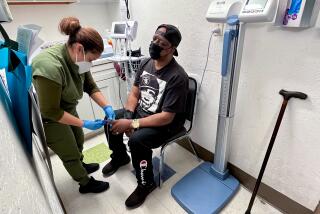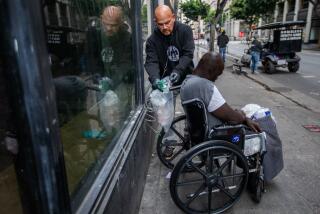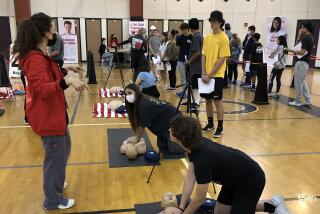SCIENCE / MEDICINE : Breathing Room : Surgically Implantable Device Offers Gift of Time to Lung-Damaged Patients : Health: A plastic oxygenator placed in a blood vessel can handle 50% of lungs’ work for several days. Surgeons at County-USC Medical Center are being trained to use it.
- Share via
Start with a thin layer of tissue the size of a tennis court. Pucker it up so that it contains literally millions of microscopically tiny air sacs. Then fold it so that it forms two hollow spheres the size, and roughly the shape, of footballs.
That is the recipe for lungs. Every day, these marvelous, floppy bags suck in 10,000 quarts of air, extract life-giving oxygen for transport throughout the body and release carbon dioxide that would otherwise accumulate in the blood to toxic levels. Sleeping or waking, running or meditating, chatting or screaming, their unceasing rhythm permeates our being, like the beating heart a constant backdrop to existence--until something goes wrong and we discover just how fragile the lungs are.
Hearts are commonly operated on and frequently transplanted; livers can be partially regenerated or replaced by a dialysis machine; a broken pancreas can be circumvented with insulin injections or even replaced with a shiny metal insulin pump; even a defective brain can be treated with drugs or grafts of tissue.
The lungs are different. A drug can’t perform their function, transplants are very difficult, and machines can’t take their place. If your lungs falter, you probably will die.
But perhaps not for much longer. Utah researchers have come up with a new recipe for a lung, creating a remarkable new implantable plastic device that is not exactly an artificial lung, but the next best thing. Installed in one of the body’s large blood vessels, the device--called an intravenous oxygenator or IVOX--can shoulder as much as 50% of the lungs’ load for a few days, providing valuable time for the lung to heal itself.
Earlier this month, surgeons at LDS Hospital in Salt Lake City used the device for the first time, inserting it in 16-year-old Melicia Harvey of Arthur City, Tex., a high school student dying of adult respiratory distress syndrome (ARDS). The girl died last Wednesday, five days after the IVOX was inserted, but that was no surprise because these first studies are designed only to show that the device does no harm to patients, not that it will save their lives. Physicians do not know if the device helped her, but they say it did not harm her and was not a contributing factor in her death.
Today, the Utah researchers are at Los Angeles County-USC Medical Center, teaching surgeons there how to use it. By the end of the month, the USC physicians hope to have used it in a patient themselves, the first step in the lengthy procedure required for approval of the device by the Food and Drug Administration.
Although the IVOX device has been extensively tested in animals, many questions about its efficacy and safety remain to be answered.
And the device’s developer, Dr. J. D. Mortensen, a thoracic surgeon who left the University of Utah to found Cardiopulmonics Inc. of Salt Lake City, is remaining deliberately low-key about it, shunning the communications media and refusing to answer most questions about IVOX’s development. “We don’t want to raise patients’ hopes prematurely,” he said in a short telephone interview.
Mortensen is also mindful of the inglorious history of two other developments at the University of Utah, the artificial heart, which has never lived up to the initial promises of its developers, and cold fusion, which last year was offered as a solution to the world’s energy problems but is now little more than a laboratory curiosity. “This is not the time or place for this (IVOX) to hit the lay press. . . . We can’t stand any more of that in Utah,” he said.
Nonetheless, said Dr. James A. Tuchschmidt, the USC pulmonologist who along with thoracic surgeon Steven Stain is in charge of testing the device there, IVOX is one of the most promising techniques developed to treat ARDS. It could provide a relatively simple and inexpensive solution to a major medical problem, he said.
But other researchers, such as Dr. Claude J. Lenfant, director of the National Heart, Lung and Blood Institute in Bethesda, Md., caution that other potential techniques for treating ARDS have shown promise in animals, only to disappoint when used in humans.
ARDS is a rather loosely defined syndrome that is frequently a consequence of drug overdoses, trauma from accidents, surgery, viral pneumonia and other serious illnesses. The condition usually develops within hours to days after hospitalization for the primary illness.
Its major signs are congestion and accumulation of blood and fluids in the lung, followed by scarring of lung tissue. These changes all impair transfer of oxygen from the lungs to the blood stream, leading to shortness of breath, rapid breathing, grunting and eventually death.
Statistics on ARDS are not kept regularly, but a committee at the lung and blood institute estimated several years ago that about 15,000 Americans suffer from the syndrome each year, most of them young people who were previously healthy. As many as 90% of ARDS victims die of it. Those that do survive typically require 6 to 12 months to recover.
The principal treatment for ARDS now is to have the patient breathe high concentrations of oxygen so that more will reach the blood stream; typically, this oxygen is delivered under pressure, also to force more oxygen into the bloodstream.
Ironically, both high pressure and high oxygen concentrations in the lung can produce ARDS, so regulating this therapy requires a delicate hand. “Which is worse, the disease or the therapy?” Tuchschmidt said. “I really don’t know.”
In the early 1970s, the lung and blood institute carried out a major study of oxygenation of the blood outside the body by heart/lung machines--the Extracorporeal Membrane Oxygenator Study, commonly known as ECMO. It was a failure.
Researchers found that the heart/lung machines did, in fact, oxygenate the blood, but side effects produced by the apparatus offset any benefit and the death rate of ARDS victims did not drop. Only eight of 90 patients in the study survived.
(ECMO is much more successful in treating infant respiratory distress syndrome, which is caused by immaturity of the lungs in premature infants. The machine permits the lungs to mature, and the otherwise healthy infants’ recuperative powers offset the side effects of the apparatus.)
Lung researchers are still studying variants of ECMO that appear more promising than the original devices, but none have reported great improvements.
Mortensen, now 70, retired from treating patients in 1980 to develop the new device. “We needed an improved way to keep patients alive while their lungs healed,” he said. “The technology for building mechanical oxygenators had advanced to the point where it appeared feasible to put a high technology one inside the vena cava (the main vein that carries blood from the lower body to the heart). It became obvious in 1980 that we could.”
Despite Mortensen’s initial optimism about the practicality of an artificial oxygenator, it has taken 10 years for him to reach the stage of clinical trials.
The current IVOX is a 20-inch-long plastic tube filled with hundreds of hollow porous polypropylene tubes, each about the thickness of a human hair. Each tube is coated with a silicon-containing plastic that allows oxygen and carbon dioxide to diffuse through it while preventing air and blood from coming into direct contact.
The tubes are jumbled together like strands of twisted spaghetti to ensure turbulent flow of blood through the device; that turbulence allows each red blood cell, which carries oxygen, to come into contact with the tubes.
An inlet tube is connected to an oxygen outlet on the wall of a hospital room. The gas flows through the device to the end, where it reverses course and passes through in the opposite direction, maximizing interaction between blood and air. The outlet is connected to the hospital’s vacuum suction system, again through an outlet on the room wall. A manifold device about the size of an automobile battery regulates pressure and flow.
To insert the device, surgeons make a tiny slit in the groin and insert IVOX into the femoral vein, the main vein in the leg. It is then threaded up into the vena cava, where it remains. The recipients are given an anticoagulant to prevent clot formation.
Researchers at Cardiopulmonics have tested the device in more than 600 animals, mostly sheep. “The animal data showed no complications at all--no infections, no blood clots, etc.,” Tuchschmidt said. In some experiments, the researchers deliberately damaged the animals’ lungs with smoke and chemicals and found that IVOX fully supported their breathing.
The human studies are starting now, Mortensen said, because “there is no other good model for treating true respiratory failure in an intensive care unit except humans.” The researchers hope the human studies will help them determine what improvements, if any, are needed to make the device more effective.
Over the next few months, the device will be installed in 40 patients at LDS Hospital, the University of Michigan Medical Center in Ann Arbor, Pennsylvania State University’s Hershey Medical Center in Hershey and County-USC.
All of the patients will be ARDS victims in whom conventional therapy has failed and who have less than a 10% chance of survival. If those tests show that the device is safe, its efficacy will be tested in another 100 patients.
FDA has approved leaving the device in patients for seven days because previous studies have shown that if an ARDS patient does not recover within a week, survival is unlikely. If a recipient needs the device longer, “we’ll deal with it patient by patient,” Tuchschmidt said.
Tuchschmidt got involved in the study after he heard Mortensen deliver a paper on IVOX at a symposium two years ago. “At first, I said, ‘Gosh, this is advertising, not science,’ ” he said. “But the more I listened, the more interested I got. I talked with Dr. Mortensen after his paper and volunteered.”
Mortensen was amenable to Tuchschmidt’s proposal because he had trained at USC himself. But more important, County-USC could offer large numbers of patients. “Some of the centers have said they can recruit perhaps six patients a year,” Tuchschmidt said. “We can get six patients in a day.”
Once Tuchschmidt and Stain are trained, they will have to receive approval from FDA, but that shouldn’t take long. “We’re hoping to be ready to go by the end of the month,” Tuchschmidt said.
Temporary Replacement for Damaged Lungs
The “artificial lung” device is surgically implanted through a vein in the leg or neck. It is designed to temporarily assist the lungs by exchanging gases in the blood, pumping in oxygen to nourish cells; and vacuuming out the poisonous carbon dioxide. The device, which can only be used for seven days, give damaged lungs a rest, so they can more effectively heal.
Artificial Lung: The intravascular oxygenator, or IVOX, is made up of hundreds of long, porous tubes about the width of a hair. The polypropylene tubes mimic the function of natural membranes within the lung sacs. The device is threaded through one of the body’s larger veins, in the leg or neck. Source: Cardiopulmonics, Inc






